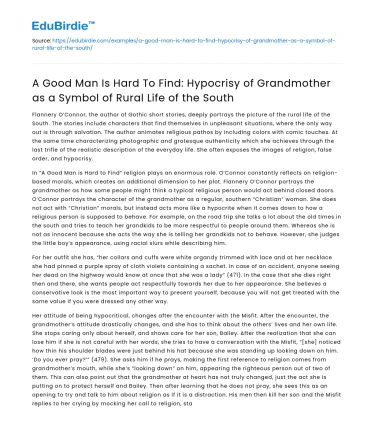Flannery O’Connor, the author of Gothic short stories, deeply portrays the picture of the rural life of the South. The stories include characters that find themselves in unpleasant situations, where the only way out is through salvation. The author animates religious pathos by including colors with comic touches. At the same time characterizing photographic and grotesque authenticity which she achieves through the last trifle of the realistic description of the everyday life. She often exposes the images of religion, false order, and hypocrisy.
In “A Good Man is Hard to Find” religion plays an enormous role. O’Connor constantly reflects on religion-based morals, which creates an additional dimension to her plot. Flannery O’Connor portrays the grandmother as how some people might think a typical religious person would act behind closed doors. O’Connor portrays the character of the grandmother as a regular, southern “Christian” woman. She does not act with “Christian” morals, but instead acts more like a hypocrite when it comes down to how a religious person is supposed to behave. For example, on the road trip she talks a lot about the old times in the south and tries to teach her grandkids to be more respectful to people around them. Whereas she is not as innocent because she acts the way she is telling her grandkids not to behave. However, she judges the little boy’s appearance, using racial slurs while describing him.
For her outfit she has, “her collars and cuffs were white organdy trimmed with lace and at her necklace she had pinned a purple spray of cloth violets containing a sachet. In case of an accident, anyone seeing her dead on the highway would know at once that she was a lady” (471). In the case that she dies right then and there, she wants people act respectfully towards her due to her appearance. She believes a conservative look is the most important way to present yourself, because you will not get treated with the same value if you were dressed any other way.
Her attitude of being hypocritical, changes after the encounter with the Misfit. After the encounter, the grandmother’s attitude drastically changes, and she has to think about the others’ lives and her own life. She stops caring only about herself, and shows care for her son, Bailey. After the realization that she can lose him if she is not careful with her words, she tries to have a conversation with the Misfit, “[she] noticed how thin his shoulder blades were just behind his hat because she was standing up looking down on him. ‘Do you ever pray?’” (479). She asks him if he prays, making the first reference to religion comes from grandmother’s mouth, while she’s “looking down” on him, appearing the righteous person out of two of them. This can also point out that the grandmother at heart has not truly changed, just the act she is putting on to protect herself and Bailey. Then after learning that he does not pray, she sees this as an opening to try and talk to him about religion as if it is a distraction. His men then kill her son and the Misfit replies to her crying by mocking her call to religion, stating: “’Jesus was the only One that ever raised the dead” (480). Giving her the hint, that he cannot be saved by Jesus and that it would take more than a religious character to save his soul. One of the last claims she says: “Why you’re one of my babies. You’re one of my own children!” as if she is a pastor claiming him as a student who needs to know they are loved by God (481). The grandmother likely recalls, the stories of Jesus telling people that he is the teacher who will save their souls and help them get to Heaven. She attempts to copy this characteristic with intent of not saving others but instead herself. This is the grandmother’s last hope to save herself, and potentially the Misfit.
Flannery O’Connor succeeds in portraying the grandmother as a hypocritical person when it comes to religion. The grandmother does not understand that there is no way of saving her life, despite her pleas for salvation. Before her end, the grandmother prays for her own soul, pretending to care for the soul of the Misfit. It is evident that O’Connor tries to reflect religion-based morals, by showing that not everyone acts the way they should.






 Stuck on your essay?
Stuck on your essay?

